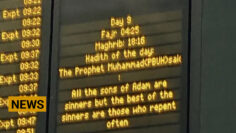
Eid-ul-Fitr 2023 moon sighting highlights: Shawwal crescent moon sighted in Saudi, UAE, Muslims to mark Eid on April 21
Eid-ul-Fitr 2023 moon sighting highlights: Saudi Arabia, UAE Muslims to mark Eid on April 21, Shawwal crescent moon sighted amid rare hybrid total solar eclipse
Eid moon sighting refers to the traditional practice of Muslims observing the crescent or new moon to determine the start of the tenth Islamic month of Shawwal, which marks the end of a month-long fasting of Ramadan and the beginning of the Eid-ul-Fitr festival where the sighting of the new moon is traditionally done with the naked eye or using telescopes and once the sighting is confirmed, the news is usually broadcasted via media outlets, mosques and community organizations but it’s important to note that the exact method of determining the start of the month of Shawwal may vary between different Muslim communities and countries. The ninth month in the Islamic Lunar Calendar is Ramadan and the tenth is Shawwal whose first day is marked as the festival of Eid-ul-Fitr across the world and Muslims across the world are gearing up to sight the crescent moon tonight, to welcome the month of Shawwal with Eid-ul-Fitr or Eid-al-Fitr celebrations as Shawwal translates to, ‘festival of breaking of the fast.’
While the West culturally follows the Gregorian calendar, the Islamic calendar is lunar which means it is based on the sighting of the crescent moon and every year, Ramadan and Eid-ul-Fitr occur approximately 10-11 days earlier depending on when the crescent moon is sighted. This is because the lunar months are shorter than solar months and so it varies from country to country by about a day.
Ramadan takes place for 720 hours i.e. four weeks and two days during which the followers of Islam or Muslims fast between dawn and sunset, pray for peace and guidance, give back to the community in the form of charity or zakaat or engaging in humanitarian activities such as feeding the underprivileged and introspect to enlighten their souls. During the end of Ramadan, intense prayers take place during the Laylatul Qadr or the Night of Power, which is believed to be the holiest night of the year. It generally falls on the 27th day of Ramadan and is a commemoration of the night when the Quran was first revealed to the Prophet Muhammad.
UK Muslims to sight the Eid 2023 crescent moon tonight
UK’s Islamic Relief, Wifaqul Ulama has made appeal to Muslims there to sight the New Moon of the month of Shawwal 1444 on April 20, 2023, the 29th Ramaḍān 1444.
Philippines to celebrated Eid-ul-Fitr 2023 on Saturday
According to Bangsamoro Darul-Ifta’, the Islamic Advisory Council of the Bangsamoro Autonomous Region in Muslim Mindanao (BARMM), the first day of Eid al Fitr in the Philippines will be on Saturday as Shiek Abuhuraira Udasan, Grand Mufti of the Bangsamoro region, said the crescent moon was not sighted in Mindanao, including Maguindanao del Norte, Tawi-Tawi, Sulu, Basilan, as well as the cities of Cotabato and Iligan on Thursday.
Muslims in Malaysia to celebrated Eid-ul-Fitr 2023 on Saturday
Eid Al Fitr will be celebrated on Saturday, April 22 in Malaysia, as the crescent moon was not spotted on Thursday, April 20.
Shawwal crescent moon not sighted in Thailand, Eid-ul-Fitr 2023 to be celebrated on
Eid will be celebrated on Saturday in Thailand, as the moon was not spotted in the country on Thursday.
Shawwal crescent moon not sighted in Japan, Eid-ul-Fitr 2023 to be celebrated on Saturday
Eid Al Fitr will fall on Saturday, April 22, in Japan, on account of the moon not being sighted on Thursday
Eid-ul-Fitr 2023 date Indonesia
The Shawwal crescent was not spotted on April 20 from Indonesia, making Saturday, April 22, the first day of Eid in the country.
Qatar confirms first day of Eid Al Fitr 2023
Following a meeting of the moon-sighting committee, Qatar confirms first day of Eid Al Fitr 2023.
Oman announces Saturday as first day of Eid Al Fitr 2023
The moon-sighting committee convened on Thursday at Oman and announced Saturday, April 22, 2023 as first day of Eid Al Fitr.
Eid-ul-Fitr 2023 moon sighting predictions and forecast amid hybrid total solar eclipse
As per astronomical reports, the Shawwal crescent moon will be just 0.2% lit right after sunset and almost certainly impossible to see for few minutes after sunset on Thursday, April 20 in Mecca, Saudi Arabia, due to the rare hybrid total solar eclipse, also known as an annular-total solar eclipse. On the other hand, the West coast of the US will most likely see it 1% lit and a little higher in the post-sunset sky about 10 hours later.
On Friday, April 21, 2023 the crescent moon is much more likely to be sighted from everywhere around the world and it will be 2.4% lit from Mecca and generally much higher and brighter in the post-sunset sky while it will be about 4% from the West coast of the US.
France to sight the Shawwal crescent for Eid 2023
The French Council of the Muslim Faith (CFCM) of France has made appeal to Muslims in the country to sight the New Moon of the month of Shawwal 1444 on April 20, 2023, the 29th Ramaḍān 1444.
USA announces Eid-ul-Fitr 2023 date
The Fiqh Council of North America shared, “The Astronomical New Moon is on Thursday, April 20, 2023, at 4:12 Universal Time. On April 20, the elongation is more than 8 degrees and moon is more than 5 degrees above the sun everywhere in North America. Hence the first day of Shawwal is on Friday, April 21, 2023, insha’Allah.” The council recognises astronomical calculation as an acceptable Shar’i method for determining the beginning of lunar months including the months of Ramadan and Shawwal.
International Astronomy Centre says crescent moon of Shawwal will not be visible to naked eye tonight
International Astronomy Centre statement read, “It is important to note that the issue of crescent sighting has been a topic of discussion among our esteemed scholars, and our Muslim ancestors established several criteria for sighting the crescent through practical observations. These standards are still rigorously followed today and are known for their accuracy in determining the possibility of seeing the crescent with the naked eye.
In fact, all previous standards, old and new, show that seeing the crescent on Thursday is not possible with the naked eye from the Arab world. This expectation is not an opinion of a person or a party, but rather it is a consensus of specialists.
Returning to the crescent on Thursday, April 20, let us look at its situation in some Arab and Islamic cities. At sunset: In Jakarta, the moon is 2.7 degrees from the sun (the internationally agreed limit for Danjeon is 6 degrees). In Abu Dhabi, it is 4.7 degrees from the sun. And in Mecca, it is 5.1 degrees away from the sun. In Jerusalem, the moon is 5.4 degrees away from the sun. In Cairo, the moon is 5.5 degrees away from the sun. In Dakar (Senegal), the moon is 8.0 degrees away from the sun, and it can be seen with instruments.
In view of all the scientific standards considered for the crescent and published in peer-reviewed periodicals, we would like to point out that seeing the crescent is not possible with the naked eye in the Arab or Islamic world, and is not even possible using telescopes in most of them, and most of them are less than the ‘Dangon’ limit.
Some countries are content with mathematical calculations to determine the moon’s position relative to the sun and do not require actual sighting of the crescent. In addition, these countries are content with the possibility of observing the crescent from anywhere in the world that shares the same night as them. Therefore, it is perfectly alright for these countries to celebrate Eid Al Fitr on Friday, April 21, if they choose to do so.
As for countries that require local (correct) vision only with the naked eye or countries located in Asia that accept local vision with a telescope, it is assumed that the number of Ramadan will be 30 days and that Eid Al Fitr will be on Saturday, April 22.
This, and announcing the beginnings of the Hijri months is, of course, the prerogative of the legal authorities in Islamic countries.”








